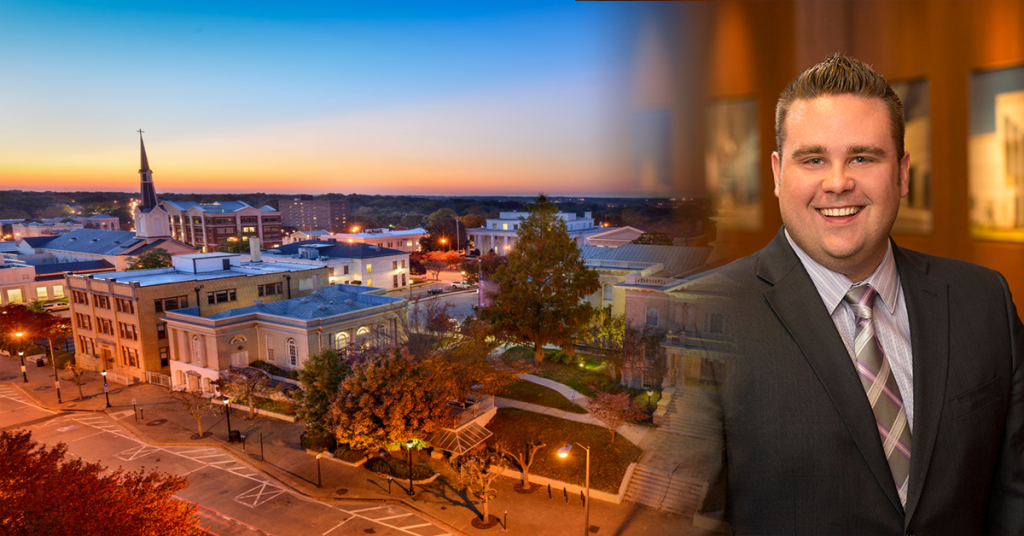Perspectives in Design | Revitalizing the College Town: Designing the Framework for a Thriving Community

by Michael McCloskey, Principal, AIA, LEED AP BD+C
At a time when society must embrace social distancing in response to the COVID-19 pandemic, and many colleges and universities have shuttered as a preventative measure to the spread of the disease, it might seem strange to discuss how design can integrate college towns and campuses – thus bringing these communities closer together.
However, we at Bernardon remain optimistic that we as a society will overcome COVID-19 within the coming months and that soon America’s universities and college towns can continue to connect, so that their student bodies and communities will continue to thrive. This article serves to explore how architecture and urban design will be catalysts to this revitalization.
Whether jetting to and from class or relaxing during an evening stroll, the college campus is a major part of the academic experience. Yet, the value of a higher education institution extends beyond the confines of the campus green. When selecting an institution for education or employment, prospective students, faculty, and staff also take into consideration its surrounding community and the manner in which the community responds to the educational institution.
With many campuses continuing to expand within the existing urban fabric of the towns, suburbs, and cities that surround them, this blending of campus and college town has become paramount to the success of both the higher education institution and the community as a whole.
Through the design and placement of buildings that promote connection, architects and urban designers can create built environments that serve to help both the campus and community to thrive. With a focus on connecting major corridors, encouraging walkability, and maintaining the essence of the community, these built environments can help to attract top talent to the campus, provide resources to help the community thrive, and overall, ensure a richer experience for all.
Revitalizing Major Corridors
In approaching the design of a successful framework, it’s vital to seek out areas that present opportunities for growth. As many college towns are built around a main corridor wherein both the student body and surrounding community often travel, this corridor serves as a means for growth and connection. In a recent design, Bernardon applied this concept to a college town corridor revitalization. By acknowledging the correlative relationship between the educational institution and its community, and through thoughtful placement of projects that addresses this relationship, we were able to create a solution that was mutually beneficial. Proposing projects along the existing corridor – including, but not limited to, student and multifamily housing, family-friendly businesses, and hotels – will address the needs of both the campus and community. Furthermore, enhancing these main corridors will increase the traffic flow between the respective environments and encourage integration between the campus and community.
Encouraging Walkability
However, adding these types of projects to the existing fabric of the community is not enough. To ensure that these projects integrate the campus and community, they need to provide opportunities for the varying populations to access them. One way to do this is by encouraging walkability through their design. In a current project located near the campus of a major Mid-Atlantic university, Bernardon created a hospitality solution that provides lodging located at the center of the college town’s Main Street – a major thoroughfare that abuts the campus green – thus creating an accessible point that immerses visitors with the campus environment. By designing a density-rich, concentrated project that scales vertically, the project will not only blend within the community’s existing urban fabric, it will reduce sprawl and the need for access by car. Moreover, by reducing the need for car use, the project will be sustainable and the community will experience less traffic congestion and vehicular emissions. While focusing on each of the edges of campus and main streets, we create intersections for interactions.
Maintaining the Essence of the Community
While new development is often needed in a revitalization effort centered around campus and community integration, it’s key to also acknowledge opportunities for maintaining the essence of the community. This can include maintaining its scale and feel, and identifying opportunities for historic preservation and adaptive reuse – especially within higher education campuses and communities that have existing historic buildings. In one of our historic preservation projects at a major university, a 1926 Georgian-style home was renovated to provide new space for graduate student services and for the School of Public Policy & Administration. The renovations to the home, which had been gifted to the university in 1966 and had been used for a variety purposes, included exterior renovations that served to improve and maintain the stately, classical aesthetic that the home shared with many of the nearby academic buildings on campus. It’s through efforts such as these, that we as designers are able to honor the longstanding history and legacy of these existing environments and help to bolster their integration to help carry their academic communities forward.
In Conclusion
In an effort to revitalize a campus and its surrounding community, creating a vibrant and walkable downtown will support the institution’s abilities to recruit and retain top talent, and in exchange, serve to help spur economic growth within the community. Enabling pedestrian access, creating growth pockets, engaging with partners that will support the values of both the academic and civic environment, and providing design that honors the existing character and essence of both environments will serve to aid in revitalization and continued growth.
< Return to Blog